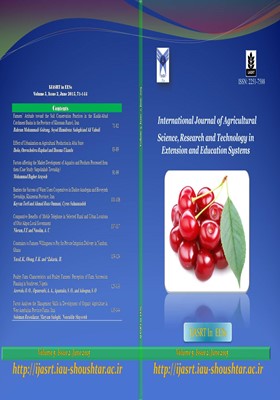Poultry Farm Characteristics and Poultry Farmers’ Perception of Farm Succession Planning in Southwest, Nigeria
محورهای موضوعی : Extension PlanningO. O Arowolo 1 , A. A Ogunronbi 2 , S. O Apantaku 3 , S. O Adeogun 4
1 - College of Agricultural Management and Rural Development, Federal University of Agriculture Abeokuta, PMB 2240, Abeokuta, Ogun State, Nigeria.
2 - College of Agricultural Management and Rural Development, Federal University of Agriculture Abeokuta, PMB 2240, Abeokuta, Ogun State, Nigeria.
3 - College of Agricultural Management and Rural Development, Federal University of Agriculture Abeokuta, PMB 2240, Abeokuta, Ogun State, Nigeria.
4 - College of Agricultural Management and Rural Development, Federal University of Agriculture Abeokuta, PMB 2240, Abeokuta, Ogun State, Nigeria.
کلید واژه: poultry farmers, farm succession planning, farmers’ perception,
چکیده مقاله :
Intergenerational succession aims at the renewal of family farm and addresses the problem of increasing aged population of principal farm owners. This study assessed poultry farm characteristics and poultry farmers’ perception of farm succession planning in southwest Nigeria. A multistage sampling procedure was used in selecting poultry farmers in Oyo and Osun states. Data were analyzed using descriptive and differential statistics. Results revealed that the poultry farmers are predominantly small and medium scale farmers. They were mostly sole proprietors (72.5%), and family farm owners (11.9%). Most (73.4%) farmers operated on full time basis, while others were either part–time or occasional farmers. Majority (95.9%) of the farmers had favourable perception towards farm succession planning, 30.3% had complete succession plan and 22.9% had commenced successor participation. There were no significant associations between farm ownership structure, but significant associations existed with farming status, total farm debt, and succession planning among the poultry farmers (p< 0.05). The study concluded that succession planning is new in the study area and must be further investigated in order to provide a data base for policy decision with regards to livestock (especially poultry) farming, aging proprietorship and encourage its practice.
1) Aderinto, A., Dada, O. M. and Ibrahim, A. (2014). Farmers’ perception of effectiveness of Agricultural Transformation Agenda in Ogun state. Journal of Agricultural Management and Rural Development (JAMARD), 5 (1): 105- 109.
2) Barclay, E. R., Foskey, R., and Reeve, I. (2007). Farm succession and inheritance – comparing Australian and International trends. A report for the rural industries research and development corporation. Retrieved from http://www.rirdc.gov.au/reports/HOC/07-066pdf
3) Becker, J. C., Fowler, C., Kaplan, M. S., Nussbaum, J., and Pitts, M. J. (2009). Dialectical tensions underpinning family farm succession planning. Journal of Applied Communication Research, 37(1): 59 – 79
4) Beginning farmers Org. (2015). Farm succession planning. Available on the: www.beginingfarmers.org/farm Retrieved in 12 June 2015.
5) Bernthal, P. and Wellins, R. (2006). Trends in leadership development and succession. Human Resource Planning, 29(3): 31 – 40.
6) Bohak, Z. (2011). Analysis of succession status and evaluation prospects of Slovene family farms. Ph.D. Thesis, University of Maribor, Faculty of Agriculture and Life Sciences, Maribor.
7) Bohak, Z. (2006). Succession status of farm with, and without successors in Municipalities of Gorisnica and Trnovska. Graduate Thesis, Faculty of Agriculture and Life Sciences, University of Maribor.
8) Corsi, A. (2004). Intra – family succession in Italian farms. In: Paper prepared for presentation at the SFER Conference. Retrieved in 15 June 2015 from http//www.childcentre.it/papers/child21_2004 ,pdf
9) De Massis, A., Chua, J. H., and Chrisman, J. J. (2008). Factors preventing Intra – family succession. Family Business Review, 21(2): 183 – 199..
10) Foskey, R. (2005). Older farmers and retirement. A report for Rural Industries Research and Development Corporation. Retrieved 10 October 2015 from htpp://www.rirdc.gov.au/reports/Hcc/05-006pdf
11) Gasson, R., Crow, G. Errington, A., Hutson, J., Marsden, T., and Winter, M. (1988). The farm as a family business: A review. Journal of Agricultural Economics, 39: 1 – 41.
12) Gale, H. F. (2003). Age specific patterns of exit and entry in U.S. farming from 1978 1997. Review of agricultural Economics, 25(1): 168 – 186.
13) Havighurst, R. J., Bernice, L.N., and Sheldon, S.T. (1968). Patterns of Aging. In Bernice, L.N. (Ed), Middle Age and Aging, Chicago: University of Chicago Press, pp 161 – 172.
14) Kerbler, B. (2007). Interrelationship between the succession status of mountain farms in Slovenia and their socio-geographic structure. Ph.D Dissertation. Faculty of Arts, University of Ljubljana, Ljubljana.
15) Kesner, I. F. and Sebora, T. C. (1994). Executive Succession: Past, Present and Future. Journal of Management, 20(2): 327 – 372.
16) Kiyonaga, N. B. (2004). Today is the tomorrow you worried about yesterday: Meeting the challenges of a changing workforce. Public Personal Management, 33(4): 357 361.
17) Lolita, Y.P. (2006). Accessibility of Rural credit among small farmers in Phillipines. A thesis presented in partial fulfillment of the requirements for Masters of Applied Sciences in Rural development, Institute of Natural Resources, Massey University, Palmerston North, New Zealand.
18) National Population Commission (NPC) (2006). Estimated Population Figures. AbujaNational Population Commission of Nigeria.
19) Ochon, A. M., Casanovas, V. O., and Almansa, S. (2007). Explaining farm succession: The impact of farm location and off – farm employment opportunities. Spanish Journal of Agricultural Research, 5: 214 – 225.
20) Schmalzried, H. & Fallon, L.F. (2007). Succession planning for local health department top executives: Reducing risk to communities. Journal of Community Health, 32(3): 169-180
21) Okpara, U.N. (2010). Personal and Socio – Economic Determinants of agricultural Information use by Farmers in Agricultural development Programme (ADP), Imo State, Nigeria. Library Phylosophy and practice, http://unilib.uni.edu/LPP/opara.htm
22) Sharma, P., Chrisman, J. J., and Chua, J. H. (2001). Predictors of satisfaction with thesuccession process in family firma: A conceptual model. Journal of Business Venturing, 18 (5): 667 -687.
23) Uchiyama, T., Lobley, M., Errington, A., and Yanagimura, S. (2008). Dimensions of intergenerational farm business transfer in Canada, England, the U S A and Japan. Japanese Journal of Rural / Economics, 10: 33 – 48.
24) Vogel, S. (2006). Farm succession planning in Austria. East European Country Side, 4: 68 – 78.


